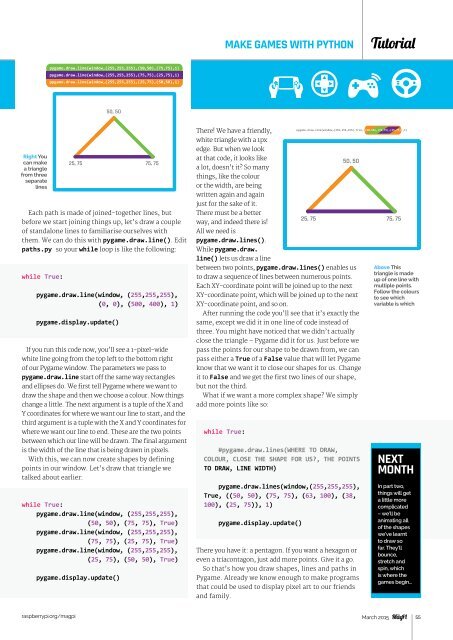Create successful ePaper yourself
Turn your PDF publications into a flip-book with our unique Google optimized e-Paper software.
MAKE GAMES WITH PYTHON<br />
Tutorial<br />
pygame.draw.line(window,(255,255,255),(50,50),(75,75),1)<br />
pygame.draw.line(window,(255,255,255),(75,75),(25,75),1)<br />
pygame.draw.line(window,(255,255,255),(25,75),(50,50),1)<br />
pygame.draw.line(window,(255,255,255),True,((50,50),(75,7<br />
(500,400))<br />
0,100,50,50))<br />
0,150,50,50))<br />
0,200,50,50))<br />
50, 50<br />
pygame.draw.line(window,(255,255,255),(75,75),(25,75),1) There! We have a friendly,<br />
pygame.draw.line(window,(255,255,255),(25,75),(50,50),1)<br />
white triangle with a 1px<br />
edge. But when we look<br />
Right You<br />
50, 50<br />
at that code, it looks like<br />
can make 25, 75 75, 75<br />
a triangle<br />
a lot, doesn’t it? So many<br />
from three<br />
things, like the colour<br />
separate<br />
lines<br />
or the width, are being<br />
25, 75 75, 75<br />
written again and again<br />
just for the sake of it.<br />
Each path is made of joined-together lines, but<br />
pygame.draw.circle(window,(255,255,0),(250,200),20,1)<br />
before we start joining things up, let’s draw a couple<br />
There must be a better<br />
way, and indeed there is!<br />
pygame.draw.circle(window,(255,255,0),(250,200),20,1)<br />
of standalone lines to familiarise ourselves with All we need is<br />
them. We can do this with pygame.draw.line(). Edit<br />
paths.py so your while loop is like the following:<br />
pygame.draw.lines().<br />
While pygame.draw.<br />
line() lets us draw a line<br />
250,200 between two points, pygame.draw.lines() enables us Above This<br />
while True: 250,200<br />
20px<br />
to draw a sequence of lines between numerous points.<br />
Each XY-coordinate point will be joined up to the next<br />
20px<br />
pygame.draw.line(window, (255,255,255), XY-coordinate point, which will be joined up to the next<br />
(0, 0), (500, 400), 1) XY-coordinate point, and so on.<br />
After running the code you’ll see that it’s exactly the<br />
pygame.display.update()<br />
same, except we did it in one line of code instead of<br />
three. You might have noticed that we didn’t actually<br />
close the triangle – Pygame did it for us. Just before we<br />
If you run this code now, you’ll see a 1-pixel-wide<br />
white line going from the top left to the bottom right<br />
of our Pygame window. The parameters we pass to<br />
pygame.draw.line start off the same way rectangles<br />
and ellipses do. We first tell Pygame where we want to<br />
draw the shape and then we choose a colour. Now things<br />
change a little. The next argument is a tuple of the X and<br />
pass the points for our shape to be drawn from, we can<br />
pass either a True of a False value that will let Pygame<br />
know that we want it to close our shapes for us. Change<br />
it to False and we get the first two lines of our shape,<br />
but not the third.<br />
What if we want a more complex shape? We simply<br />
add more points like so:<br />
Y coordinates for where we want our line to start, and the<br />
third argument is a tuple with the X and Y coordinates for<br />
where we want our line to end. These are the two points while True:<br />
between which our line will be drawn. The final argument<br />
is the width of the line that is being drawn in pixels.<br />
With this, we can now create shapes by defining<br />
points in our window. Let’s draw that triangle we<br />
#pygame.draw.lines(WHERE TO DRAW,<br />
COLOUR, CLOSE THE SHAPE FOR US?, THE POINTS<br />
TO DRAW, LINE WIDTH)<br />
talked about earlier:<br />
pygame.draw.lines(window,(255,255,255),<br />
True, ((50, 50), (75, 75), (63, 100), (38,<br />
100), (25, 75)), 1)<br />
while True:<br />
pygame.draw.line(window, (255,255,255),<br />
(50, 50), (75, 75), True)<br />
pygame.draw.line(window, (255,255,255),<br />
(75, 75), (25, 75), True)<br />
pygame.draw.line(window, (255,255,255),<br />
(25, 75), (50, 50), True)<br />
pygame.display.update()<br />
pygame.draw.line(window,(255,255,255),(50,50),(75,75),1)<br />
pygame.display.update()<br />
pygame.draw.line(window,(255,255,255),True,((50,50),(75,75),(25,75)),1)<br />
There you have it: a pentagon. If you want a hexagon or<br />
even a triacontagon, just add more points. Give it a go.<br />
So that’s how you draw shapes, lines and paths in<br />
Pygame. Already we know enough to make programs<br />
that could be used to display pixel art to our friends<br />
and family.<br />
triangle is made<br />
up of one line with<br />
multiple points.<br />
Follow the colours<br />
to see which<br />
variable is which<br />
NEXT<br />
MONTH<br />
In part two,<br />
things will get<br />
a little more<br />
complicated<br />
– we’ll be<br />
animating all<br />
of the shapes<br />
we’ve learnt<br />
to draw so<br />
far. They’ll<br />
bounce,<br />
stretch and<br />
spin, which<br />
is where the<br />
games begin…<br />
raspberrypi.org/magpi March 2015 55


